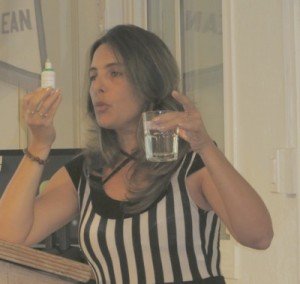There were only nine confirmed cases of dengue on Saba until November 2013, but because residents travel frequently to St. Maarten and other islands in the region, Saba is at a great risk of acquiring dengue or the chikungunya disease, Cuban medical entomologist Sandra Moreno Reyes stated. The Daily Herald reports that researcher of Cuba’s biological and pharmaceutical Labiofam group Sandra Moreno said this at a presentation on Saba’s mosquito-control project organised by Saba Reach Foundation and the Mosquito Control Department at Eugenius Johnson Center in Windwardside.
Moreno briefed participants on the long-term dynamics of worldwide infestation with Aedes aegypti, the mosquito species carrying dengue, chikungunya and other diseases. She alerted Sabans to the recent statistics released by the US Center for Disease Control, which indicates that in the past year, there were 3,095 confirmed cases of dengue on St. Maarten/St. Martin, some 11,169 cases in just one province of Colombia and some 110 deaths registered in the Dominican Republic attributed to dengue.
Saba’s population is closely tied to these three destinations. Providing information by Pan American Health Organization, Moreno highlighted the distribution of Chikungunya cases in the Caribbean and concluded that Saba is also at a great risk for this illness. She pointed to the 10 cases registered on Dutch St. Maarten and 476 cases reported on French St. Martin. Stressing that “mosquitoes do not know borders,” she said that the risk for the Saba population was substantial.
Moreno was concerned about the presence and wide distribution of the Aedes aegypti mosquito on Saba. She showed the various locations where the larvae of the mosquito were found to reproduce. During the past five months, she had been studying the locations and distribution of the various mosquito species on Saba. She surveyed 162 residents, representing 8.1 per cent of the population, and found that 88 per cent were affected by mosquito bites, while 77 per cent were unaware of prevention factors. She also found that 81 per cent could not identify symptoms associated with dengue.
In addition to Aedes aegypti, which is the most common on Saba, Moreno also found the Culex quinquefasciatus mosquito that is associated with the transmission of various types of encephalitis, including the Nile virus. The third species that is widespread in Saba is the Culex bisulcatus, which is not a carrier of diseases, but has been officially identified on Saba for the first time.
Mosquito reproduction is concentrated in people’s residential surroundings. This is especially the case with Aedes aegypti, which prefers human blood. Moreno showed photos of piles of car tires, buckets, water tanks and containers in which mosquitoes reproduce.
Saba’s Pest Control Department uses biological products to combat mosquitoes, such as the Guppy fish and Mosquito Dunks, as well as the chemical alternative Abate. Moreno warned about the toxicity and developed resistance associated with the use of chemicals and explained the benefits of biological alternatives, among which is Labiofam’s Biolarvicide Bactivec. “This product can be used by the community to play an active role in mosquito control,” she said. Labiofam oversees a chain of businesses developing vaccines and veterinary medicine as well as biological pesticides also against rats and mice.. They operate worldwide, but are especially active in the Caribbean and Latin America.
Each household received a bottle of the product for use in and outside the home. To prove it’s safety she even drank a glass of water with drops of Bactivec in her presentation.

Moreno recommended government’s involvement in creating community awareness about preventive measures against mosquito proliferation to reinforce the campaign initiated by Saba University School of Medicine’s students, who developed dengue-prevention posters with support of Saba Lions Club and Body, Mind and Spirit Foundation.
 Archive of posts from Saba-News.com Archive Saba News
Archive of posts from Saba-News.com Archive Saba News
